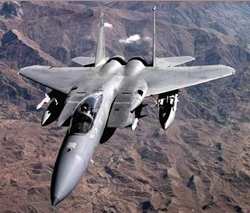Outlook is Realistic, not Cheery
 The Boeing Company yesterday
reported a net loss for the second quarter of 2003 of $192 million
on revenues of $12.8 billion. This compares with net earnings of
$779 million, on revenues of $13.9 billion for the second quarter
of 2002.
The Boeing Company yesterday
reported a net loss for the second quarter of 2003 of $192 million
on revenues of $12.8 billion. This compares with net earnings of
$779 million, on revenues of $13.9 billion for the second quarter
of 2002.
On July 15, 2003, the company disclosed it would recognize
charges related to its launch and satellite
businesses. These charges decreased net earnings
for the quarter by $693 million, or $0.87 per share.
 "We took strong actions
this quarter to recognize and address the challenges in our
commercial space businesses," said Boeing Chairman and Chief
Executive Officer Phil Condit. "Our strong defense portfolio again
performed well, and Commercial Airplanes and Boeing Capital
Corporation are successfully managing through the downturn for
strong future returns."
"We took strong actions
this quarter to recognize and address the challenges in our
commercial space businesses," said Boeing Chairman and Chief
Executive Officer Phil Condit. "Our strong defense portfolio again
performed well, and Commercial Airplanes and Boeing Capital
Corporation are successfully managing through the downturn for
strong future returns."
The company reported losses from operations totaling $293
million in the second quarter compared with earnings from
operations of $1.2 billion in the second quarter of 2002.
Previously announced charges related to the satellite and launch
businesses reduced earnings from operations $1.1 billion.
Boeing Commercial Airplanes
Commercial Airplanes continues to aggressively
manage for profitability through the unprecedented downturn in its
markets while focusing on the future. During the quarter,
Commercial Airplanes continued to resize operations, improve
efficiency, and pursue a disciplined product development strategy,
including the new 7E7 airplane. As part of
resizing operations, after the quarter Commercial Airplanes
announced additional employment reductions of 4,000 to 5,000
people, bringing year-end employment estimates in the range of
55,000 to 56,000.
During the second quarter, deliveries of commercial airplanes
decreased 34 percent to 74 airplanes, and revenues fell 24 percent
to $5.8 billion when compared with the second quarter of 2002.
Earnings from operations totaled $313 million, and reflect
significantly lower deliveries and revenues and higher pension
expense, offset by good performance and lower R&D spending.
Operating margins were 5.4 percent in the period compared to 7.3
percent for the second quarter last year.
Integrated Defense Systems
 Integrated Defense
Systems’ revenues increased 7 percent to $6.6 billion, up
from $6.1 billion in the second quarter of 2002. Reported operating
losses totaled $429 million compared with earnings from operations
of $639 million in the second quarter of 2002 due to the previously
disclosed charges recognized primarily in the Launch and Orbital
Systems segment. Aircraft, weapon, military support and
network-centric programs continued to perform well.
Integrated Defense
Systems’ revenues increased 7 percent to $6.6 billion, up
from $6.1 billion in the second quarter of 2002. Reported operating
losses totaled $429 million compared with earnings from operations
of $639 million in the second quarter of 2002 due to the previously
disclosed charges recognized primarily in the Launch and Orbital
Systems segment. Aircraft, weapon, military support and
network-centric programs continued to perform well.
Network Systems
Results reflected continued growth in its homeland security and
Department of Defense (DoD) network-centric program base as
revenues rose 13 percent to $2.2 billion. Operating margins were
4.5 percent, down from 7.3 percent last year, due to previously
disclosed cost growth on DoD satellite programs.
Support Systems
Support Systems delivered strong growth, with revenues up 18
percent to just over $1.0 billion on significant increases in
tactical and transport aircraft spares and modernization. Operating
margins remained excellent at 10.5 percent compared with 10.7
percent in the second quarter of 2002.
Launch and Orbital Systems
Revenues for the quarter were up 14 percent to $770 million on
higher satellite deliveries. Charges recognized during the period,
as previously announced, resulted in an operating loss of
approximately $1 billion.
Boeing Capital Corporation
 During the quarter, revenues
increased 13 percent to $287 million as a result of portfolio
growth during 2003. Pre-tax income, including interest expense,
totaled $72 million compared with $73 million in the second quarter
of 2002. The slight decline primarily reflects higher depreciation
expenses when compared with the second quarter of 2002, largely
offset by increased revenues.
During the quarter, revenues
increased 13 percent to $287 million as a result of portfolio
growth during 2003. Pre-tax income, including interest expense,
totaled $72 million compared with $73 million in the second quarter
of 2002. The slight decline primarily reflects higher depreciation
expenses when compared with the second quarter of 2002, largely
offset by increased revenues.
At quarter-end, approximately 78 percent of Boeing Capital
Corporation's portfolio was related to Boeing products and services
(primarily commercial aircraft) compared with 76 percent at the end
of the first quarter.
"Other"
The "Other" segment consists chiefly of the Connexion by Boeing,
Air Traffic Management, and Boeing technology units, as well as
certain results related to the consolidation of all business units.
Losses from operations for the quarter totaled $57 million as
Connexion by Boeing prepares to launch full-scale service in
2004.
During the second quarter, Connexion by Boeing
completed successful consumer trials with Lufthansa and British
Airways, and signed an initial service agreement with Lufthansa for
88 aircraft. Boeing’s Air Traffic Management unit continued
to build support for a modernized global air traffic management
system, signing an agreement with the Air Traffic Alliance to
cooperate on several projects around the world.
Outlook: a billion here, a billion there.
Boeing Commercial Airplanes’ deliveries
forecast for 2003 is unchanged. The delivery forecast for 2003
remains approximately 280 airplanes and is virtually sold out. The
delivery forecast for 2004 has been narrowed from between 275 and
300 airplanes to between 275 and 290 airplanes. The 2004 delivery
forecast is now approximately 90 percent sold at the lower end of
the range. Commercial Airplanes expects demand for aircraft
services and spares to remain soft due to severe market
conditions.
Boeing Capital Corporation portfolio growth is expected to slow
as airplane delivery rates remain at depressed levels. BCC is
focused on minimizing risk and preserving value with prudently
structured transactions and portfolio management.
The outlook for 2003 revenues is unchanged at +/- $49 billion.
The company is revising its 2004 revenue outlook from $52 - $54
billion to +/- $52 billion.
 Aero-News: Quote of the Day (12.07.25)
Aero-News: Quote of the Day (12.07.25) ANN's Daily Aero-Linx (12.07.25)
ANN's Daily Aero-Linx (12.07.25) NTSB Final Report: Lafferty Jack Sea Rey
NTSB Final Report: Lafferty Jack Sea Rey Classic Aero-TV: The B29 SuperFortress Doc - History in Flight
Classic Aero-TV: The B29 SuperFortress Doc - History in Flight Airborne 12.08.25: Samaritans Purse Hijack, FAA Med Relief, China Rocket Fail
Airborne 12.08.25: Samaritans Purse Hijack, FAA Med Relief, China Rocket Fail






